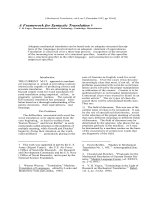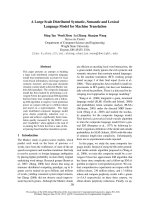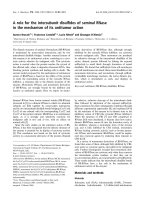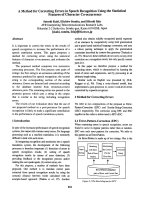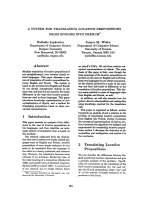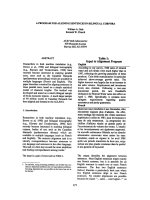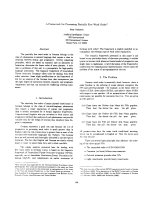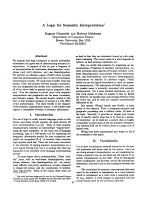Báo cáo khoa học: "a Toolkit for Distributed Perceptron Training and Prediction with MapReduce" doc
Bạn đang xem bản rút gọn của tài liệu. Xem và tải ngay bản đầy đủ của tài liệu tại đây (644.54 KB, 5 trang )
Proceedings of the 13th Conference of the European Chapter of the Association for Computational Linguistics, pages 97–101,
Avignon, France, April 23 - 27 2012.
c
2012 Association for Computational Linguistics
HadoopPerceptron: a Toolkit for Distributed Perceptron Training and
Prediction with MapReduce
Andrea Gesmundo
Computer Science Department
University of Geneva
Geneva, Switzerland
Nadi Tomeh
LIMSI-CNRS and
Universit´e Paris-Sud
Orsay, France
Abstract
We propose a set of open-source software
modules to perform structured Perceptron
Training, Prediction and Evaluation within
the Hadoop framework. Apache Hadoop
is a freely available environment for run-
ning distributed applications on a com-
puter cluster. The software is designed
within the Map-Reduce paradigm. Thanks
to distributed computing, the proposed soft-
ware reduces substantially execution times
while handling huge data-sets. The dis-
tributed Perceptron training algorithm pre-
serves convergence properties, thus guar-
anties same accuracy performances as the
serial Perceptron. The presented modules
can be executed as stand-alone software or
easily extended or integrated in complex
systems. The execution of the modules ap-
plied to specific NLP tasks can be demon-
strated and tested via an interactive web in-
terface that allows the user to inspect the
status and structure of the cluster and inter-
act with the MapReduce jobs.
1 Introduction
The Perceptron training algorithm (Rosenblatt,
1958; Freund and Schapire, 1999; Collins, 2002)
is widely applied in the Natural Language Pro-
cessing community for learning complex struc-
tured models. The non-probabilistic nature of the
perceptron parameters makes it possible to incor-
porate arbitrary features without the need to cal-
culate a partition function, which is required for
its discriminative probabilistic counterparts such
as CRFs (Lafferty et al., 2001). Additionally, the
Perceptron is robust to approximate inference in
large search spaces.
Nevertheless, Perceptron training is propor-
tional to inference which is frequently non-linear
in the input sequence size. Therefore, training can
be time-consuming for complex model structures.
Furthermore, for an increasing number of tasks is
fundamental to leverage on huge sources of data
as the World Wide Web. Such difficulties render
the scalability of the Perceptron a challenge.
In order to improve scalability, Mcdonald et
al. (2010) propose a distributed training strat-
egy called iterative parameter mixing, and show
that it has similar convergence properties to the
standard perceptron algorithm; it finds a separat-
ing hyperplane if the training set is separable; it
produces models with comparable accuracies to
those trained serially on all the data; and reduces
training times significantly by exploiting comput-
ing clusters.
With this paper we present the HadoopPer-
ceptron package. It provides a freely available
open-source implementation of the iterative pa-
rameter mixing algorithm for training the struc-
tured perceptron on a generic sequence labeling
tasks. Furthermore, the package provides two ad-
ditional modules for prediction and evaluation.
The three software modules are designed within
the MapReduce programming model (Dean and
Ghemawat, 2004) and implemented using the
Apache Hadoop distributed programming Frame-
work (White, 2009; Lin and Dyer, 2010). The
presented HadoopPerceptron package reduces ex-
ecution time significantly compared to its serial
counterpart while maintaining comparable perfor-
mance.
97
PerceptronIterParamMix(T = {(x
t
, y
t
)}
|T |
t=1
)
1. Split T into S pieces T = {T
1
, . . . , T
S
}
2. w = 0
3. for n : 1 N
4. w
(i,n)
= OneEpochPerceptron(T
i
, w)
5. w =
i
µ
i,n
w
(i,n)
6. return w
OneEpochPerceptron(T
i
, w
∗
)
1. w
(0)
= w
∗
; k = 0
2. for n : 1 T
3. Let y
′
= arg max
y
′
w
(k)
.f(x
t
, y
′
t
)
4. if y
′
= y
t
5. x
(k+1)
= x
(k)
+ f (x
t
, y
t
) − f(x
t
, y
′
t
)
6. k = k + 1
7. return w
(k)
Figure 1: Distributed perceptron with iterative param-
eter mixing strategy. Each w
(i,n)
is computed in par-
allel. µ
n
= {µ
1,n
, . . . , µ
S,n
}, ∀µ
i,n
∈ µ
n
: µ
i,n
≥
0 and ∀n :
i
µ
i,n
= 1.
2 Distributed Structured Perceptron
The structured perceptron (Collins, 2002) is an
online learning algorithm that processes train-
ing instances one at a time during each training
epoch. In sequence labeling tasks, the algorithm
predicts a sequence of labels (an element from
the structured output space) for each input se-
quence. Prediction is determined by linear opera-
tions on high-dimensional feature representations
of candidate input-output pairs and an associated
weight vector. During training, the parameters are
updated whenever the prediction that employed
them is incorrect.
Unlike many batch learning algorithms that can
easily be distributed through the gradient calcula-
tion, the perceptron online training is more subtle
to parallelize. However, Mcdonald et al. (2010)
present a simple distributed training through a pa-
rameter mixing scheme.
The Iterative Parameter Mixing is given in Fig-
ure 2 (Mcdonald et al., 2010). First the training
data is divided into disjoint splits of example pairs
(x
t
, y
t
) where x
t
is the observation sequence and
y
t
is the associated labels. The algorithm pro-
ceeds to train a single epoch of the perceptron
algorithm for each split in parallel, and mix the
local models weights w
(i,n)
to produce the global
weight vector w. The mixed model is then passed
to each split to reset the perceptron local weights,
and a new iteration is started. Mcdonald et al.
(2010) provide bound analysis for the algorithm
and show that it is guaranteed to converge and find
a seperation hyperplane if one exists.
3 MapReduce and Hadoop
Many algorithms need to iterate over number
of records and 1) perform some calculation on
each of them and then 2) aggregate the results.
The MapReduce programming model implements
a functional abstraction of these two operations
called respectively Map and Reduce. The Map
function takes a value-key pairs and produces a
list of key-value pairs: map(k , v) → (k
′
, v
′
)
∗
;
while the input the Reduce function is a key with
all the associated values produced by all the map-
pers: reduce(k
′
, (v
′
)
∗
) → (k
′′
, v
′′
)
∗
. The model
requires that all values with the same key are re-
duced together.
Apache Hadoop is an open-source implementa-
tion of the MapReduce model on cluster of com-
puters. A cluster is composed by a set of comput-
ers (nodes) connected into a network. One node
is designated as the Master while other nodes
are referred to as Worker Nodes. Hadoop is de-
signed to scale out to large clusters built from
commodity hardware and achieves seamless scal-
ability. To allow rapid development, Hadoop
hides system-level details from the application
developer.The MapReduce runtime automatically
schedule worker assignment to mappers and re-
ducers;handles synchronization required by the
programming model including gathering, sort-
ing and shuffling of intermediate data across the
network; and provides robustness by detecting
worker failures and managing restarts. The frame-
work is built on top of he Hadoop Distributed
File System (HDFS), which allows to distribute
the data across the cluster nodes. Network traffic
is minimized by moving the process to the node
storing the data. In Hadoop terminology an entire
MapReduce program is called a job while individ-
ual mappers and reducers are called tasks.
4 HadoopPerceptron Implementation
In this section we give details on how the train-
ing, prediction and evaluation modules are im-
plemented for the Hadoop framework using the
98
Figure 2: HadoopPerceptron in MapReduce.
MapReduce programming model
1
.
Our implementation of the iterative parame-
ter mixing algorithm is sketched in Figure 2.
At the beginning of each iteration, the train-
ing data is split and distributed to the worker
nodes. The set of training examples in a
data split is streamed to map workers as pairs
(sentence-id, (x
t
, y
t
)). Each map worker per-
forms a standard perceptron training epoch and
outputs a pair (feature-id, w
i,f
) for each feature.
The set of such pairs emitted by a map worker rep-
resents its local weight vector. After map workers
have finished, the MapReduce framework guaran-
tees that all local weights associated with a given
feature are aggregated together as input to a dis-
tinct reduce worker. Each reduce worker produces
as output the average of the associated feature
weight. At the end of each iteration, the reduce
workers outputs are aggregated into the global av-
eraged weight vector. The algorithm iterates N
times or until convergence is achieved. At the
beginning of each iteration the weight vector of
each distinct model is initialized with the global
averaged weight vector resultant from the previ-
ous iteration. Thus, for all the iterations except
for the first, the global averaged weight vector re-
sultant from the previous iteration needs to be pro-
vided the map workers. In Hadoop it is possible
to pass this information via the Distributed Cache
System.
In addition to the training module, the Hadoop-
Perceptron package provides separate modules
for prediction and evaluation both of them are
designed as MapReduce programs. The evalu-
1
The Hadoop Perceptron toolkit is available from
.
ation module output the accuracy measure com-
puted against provided gold standards. Prediction
and evaluation modules are independent from the
training modules, the weight vector given as input
could have been computed with any other system
using any other training algorithm as long as they
employ the same features.
The implementation is in Java, and we inter-
face with the Hadoop cluster via the native Java
API. It can be easily adapted to a wide range of
NLP tasks. Incorporating new features by mod-
ifying the extensible feature extractor is straight-
forward. The package includes the implementa-
tion of the basic feature set described in (Suzuki
and Isozaki, 2008).
5 The Web User Interface
Hadoop is bundled with several web interfaces
that provide concise tracking information for jobs,
tasks, data nodes, etc. as shown in Figure 3. These
web interfaces can be used to demonstrate the
HadoopPerceptron running phases and monitor
the distributed execution of the training, predic-
tion and evaluation modules for several sequence
labeling tasks including part-of-speech tagging
and named entity recognition.
6 Experiments
We investigate HadoopPerceptron training time
and prediction accuracy on a part-of-speech
(POS) task using the PennTreeBank corpus (Mar-
cus et al., 1994). We use sections 0-18 of the Wall
Street Journal for training, and sections 22-24 for
testing.
We compare the regular percepton trained se-
rially on all the training data with the distributed
perceptron trained with iterative parameter mix-
ing with variable number of splits S ∈ {10, 20}.
For each system, we report the prediction accu-
racy measure on the final test set to determine
if any loss is observed as a consequence of dis-
tributed training.
For each system, Figure 4 plots accuracy re-
sults computed at the end of every training epoch
against consumed wall-clock time. We observe
that iterative mixing parameter achieves compa-
rable performance to its serial counterpart while
converging orders of magnitude faster.
Furthermore, we note that the distributed al-
gorithm achieves a slightly higher final accuracy
99
Figure 3: Hadoop interfaces for HadoopPerceptron.
Figure 4: Accuracy vs. training time. Each point cor-
responds to a training epoch.
than serial training. Mcdonald et al. (2010) sug-
gest that this is due to the bagging effect that
the distributed training has, and due to parameter
mixing that is similar to the averaged perceptron.
We note also that increasing the number of
splits increases the number of epoch required to
attain convergence, while reducing the time re-
quired per epoch. This implies a trade-off be-
tween slower convergence and quicker epochs
when selecting a larger number of splits.
7 Conclusion
The HadoopPerceptron package provides the first
freely-available open-source implementation of
iterative parameter mixing Perceptron Training,
Prediction and Evaluation for a distributed Map-
Reduce framework. It is a versatile stand alone
software or building block, that can be easily
extended, modified, adapted, and integrated in
broader systems.
HadoopPerceptron is a useful tool for the in-
creasing number of applications that need to per-
form large-scale structured learning. This is the
first freely available implementation of an ap-
proach that has already been applied with success
in private sectors (e.g. Google Inc.). Making it
possible for everybody to fully leverage on huge
data sources as the World Wide Web, and develop
structured learning solutions that can scale keep-
ing feasible execution times and cluster-network
usage to a minimum.
Acknowledgments
This work was funded by Google and The Scot-
tish Informatics and Computer Science Alliance
(SICSA). We thank Keith Hall, Chris Dyer and
Miles Osborne for help and advice.
100
References
Michael Collins. 2002. Discriminative training meth-
ods for hidden markov models: Theory and experi-
ments with perceptron algorithms. In EMNLP ’02:
Proceedings of the 2002 Conference on Empirical
Methods in Natural Language Processing, Philadel-
phia, PA, USA.
Jeffrey Dean and Sanjay Ghemawat. 2004. Mapre-
duce: simplified data processing on large clusters.
In Proceedings of the 6th Symposium on Opeart-
ing Systems Design and Implementation, San Fran-
cisco, CA, USA.
Yoav Freund and Robert E. Schapire. 1999. Large
margin classification using the perceptron algo-
rithm. Machine Learning, 37(3):277–296.
John Lafferty, Andrew Mccallum, and Fernando
Pereira. 2001. John lafferty and andrew mc-
callum and fernando pereira. In Proceedings of
the International Conference on Machine Learning,
Williamstown, MA, USA.
Jimmy Lin and Chris Dyer. 2010. Data-Intensive Text
Processing with MapReduce. Morgan & Claypool
Publishers.
Mitchell P. Marcus, Beatrice Santorini, and Mary A.
Marcinkiewicz. 1994. Building a large annotated
corpus of english: The penn treebank. Computa-
tional Linguistics, 19(2):313–330.
Ryan Mcdonald, Keith Hall, and Gideon Mann. 2010.
Distributed training strategies for the structured per-
ceptron. In NAACL ’10: Proceedings of the 11th
Conference of the North American Chapter of the
Association for Computational Linguistics, Los An-
geles, CA, USA.
Frank Rosenblatt. 1958. The Perceptron: A proba-
bilistic model for information storage and organiza-
tion in the brain. Psychological Review, 65(6):386–
408.
Jun Suzuki and Hideki Isozaki. 2008. Semi-
supervised sequential labeling and segmentation us-
ing giga-word scale unlabeled data. In ACL ’08:
Proceedings of the 46th Conference of the Associa-
tion for Computational Linguistics, Columbus, OH,
USA.
Tom White. 2009. Hadoop: The Definitive Guide.
O’Reilly Media Inc.
101

